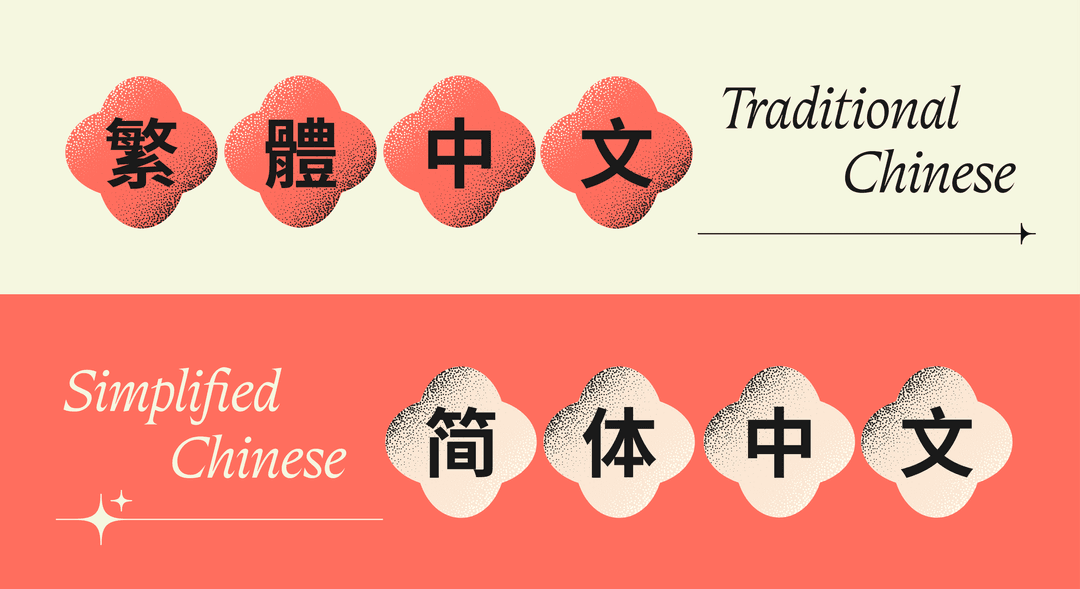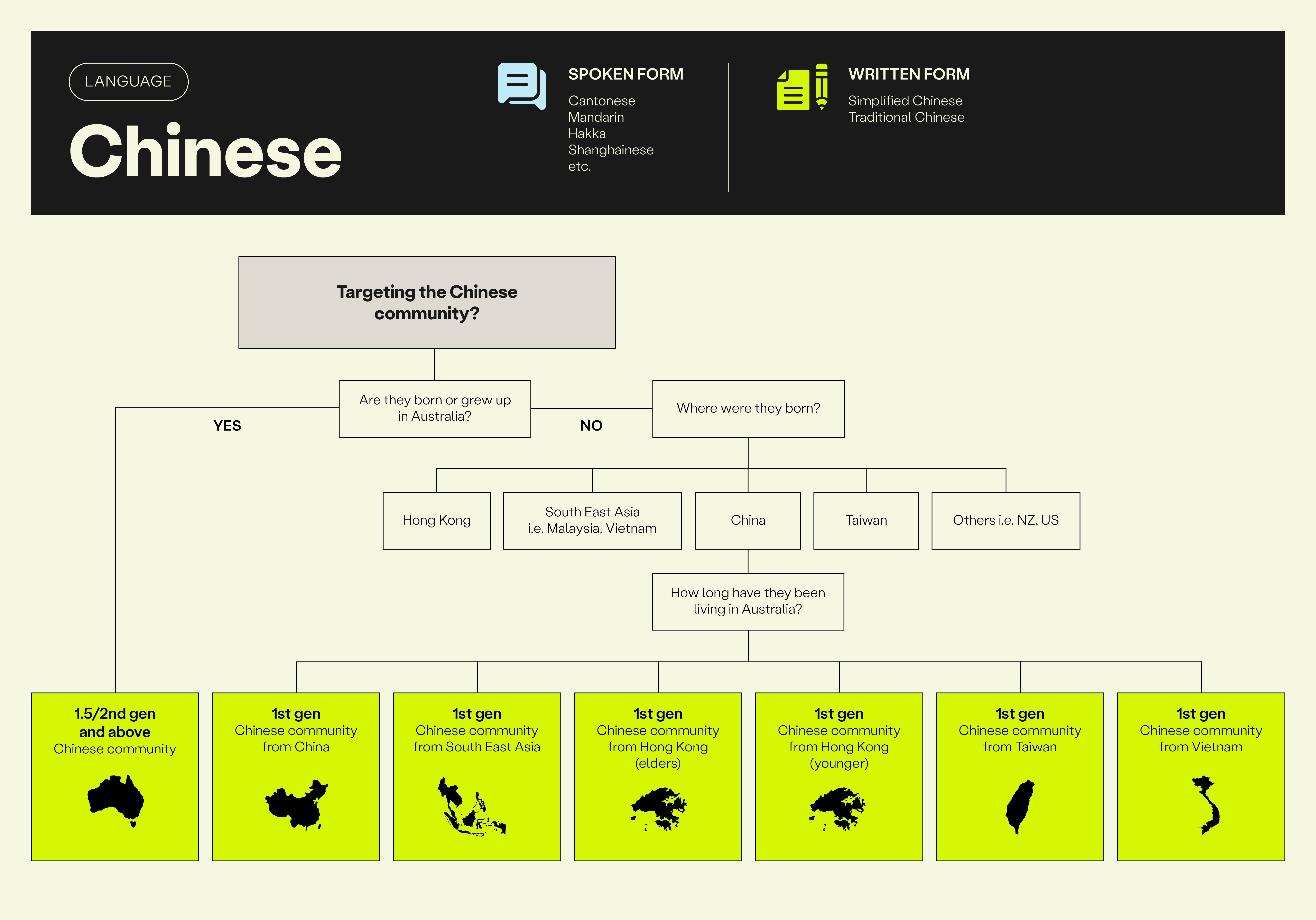Mandarin or Cantonese?

Rebecca Song answers questions we’re often asked about Chinese languages in Australia, and shares an insightful historical view of the evolving Chinese diaspora in Australia.
Have you considered engaging with the Chinese diaspora in Australia? And do you know which language you should use?
A question we get all the time is — should I translate to Mandarin or Cantonese to engage the Chinese community? However, the answer isn’t so straightforward. ‘Chinese’ means many things — it’s a nationality, and it’s also a language, a culture, a heritage, ethnicity, civilisation and a plethora of rich migration stories.
From international students from China who have just arrived to sixth-generation Chinese Australians with varied dialects and cultural roots, the community's richness goes far beyond simple language categorisation.
Before we dive into the details of translation, it's important to first consider: what is a language?
According to the Oxford English Dictionary, language is a system of spoken or written communication used by a particular country, people, or community. It typically includes spoken and written forms - and in the case of Chinese languages, these forms actually have different names. For example, Mandarin and Cantonese are spoken varieties of the Chinese language, while Simplified and Traditional Chinese represent the written forms.
Where the complexity arises, is in understanding which spoken language and written form are used by people across the Chinese diaspora. Sometimes, it’s assumed for translation purposes that Mandarin speakers use Simplified Chinese, while Cantonese speakers use Traditional Chinese. However, the reality is far more evolved. To make informed decisions about what and how to translate, let’s take a look back at how the language has evolved and the diversity within the Chinese diaspora in Australia.
Mandarin and Cantonese
Mandarin is the standardised form of spoken Chinese, and was actually developed in the 1900s to improve education and promote cohesion across all ethnic groups and regions. It was officially named the ‘Putonghua ‘ (ordinary tongue) in 1955. As of June 2020, over 80% of people in China speak Mandarin.
Cantonese, on the other hand, is one of over 2,000 spoken Chinese dialects. It’s widely used in southern China—particularly in Guangdong and Guangxi—as well as in Hong Kong and Macau.
As a recent international student, I was surprised to discover how widely Cantonese is spoken in Australia, especially since it’s spoken by less than 10% of the population in China. However, this made more sense as I learned about the history of Chinese Australians and their 200-year migration journey.
History of the Chinese-Australian Communities
Although Chinese people began engaging in trade with Australia as early as the 17th century, the first significant wave of Chinese migration occurred during the 19th-century gold rush, centring around economic opportunities. Most of these early migrants came from southern China, particularly from Guangdong and Guangxi, and spoke Cantonese. They worked in goldfields and conducted business in the surrounding communities. As many of them settled in Australia, this group of migrants became the ancestors of today’s fifth—and sixth—generation Chinese Australians, who often speak both Cantonese and English at home. This has contributed to the prominence of Cantonese beyond China and its surrounding regions. Similar migration patterns in the United States and Canada have also helped bring Cantonese to the global stage.
Fast forward to the 1970s, as the White Australia policy was abolished, a new wave of Chinese arrived in Australia, seeking educational and economic opportunities—and many chose to settle permanently. Many of these migrants moved to Australia from Hong Kong, Taiwan, Malaysia, and Singapore. This wave of migration was still predominantly made up of Cantonese speakers, with a slight increase in Mandarin speakers.
Since the 1990s, Australia has seen a steady increase in Chinese migration, with many migrants coming from the central and northern part of China—an area that experienced rapid economic and population growth. As a result, the number of Mandarin speakers in Australia has risen significantly. This wave of migration peaked in 2019, with around 36,715 Chinese migrants arriving in Australia that year alone, on mostly family and skilled pathways.
Among this group, the majority read and write Simplified Chinese and speak Mandarin. While this wave of Chinese migrants is the most recent and youngest community, its population has become the majority among Chinese communities in Australia. And in recent years family-sponsored visas also enabled Chinese people to migrate to Australia to join family members, including an increasing number of elderly Chinese people settling in Australia to live with their adult children.
This wave of migration has made Mandarin the most spoken language at home in Australia, after English.
 Factors to consider when selecting languages to reach Chinese audiences in Australia
Factors to consider when selecting languages to reach Chinese audiences in Australia
Traditional and Simplified Chinese
Traditional Chinese has been used as the official script since the dynasty period. When the People’s Republic of China was established in 1949, the government adopted and actively promoted Simplified Chinese. This was done to make reading and writing easier to learn and implement, helping to boost literacy across the population—not just among the elite.
At the time, Simplified Chinese was adopted by Mainland China, while Hong Kong, Taiwan, and Macau were under different governance and retained the original written script—Traditional Chinese.
For Chinese communities in Southeast Asia, such as those in Malaysia and Singapore, many migrated during the dynastic periods and speak a variety of dialects. However, in recent years—especially since Hong Kong’s return to China in 1997—there has been a gradual shift. Language often follows power, and as China’s global influence has grown, many in Southeast Asia have increasingly adopted Simplified Chinese and Mandarin for practicality and economic benefits in trade and business.
Therefore, younger generations of Hongkongers and Southeast Asian Chinese migrating to Australia are generally more familiar with Simplified Chinese, though they might speak both Cantonese and Mandarin. Meanwhile, the older generation from Hong Kong and southern China might speak only Cantonese and read Traditional Chinese.
Nowadays in Australia, the major community using Traditional Chinese are migrants from Taiwan.
Chinese communities in today’s Australia
Today’s Australia includes second-generation and one-and-a-half generation individuals—those who migrated at a young age and were raised in Australia—who are well integrated into Australian society. There are also first-generation migrants who have arrived in the last 30 years through various pathways, including as international students, skilled workers, family members, or via other migration programs.
What does this all mean for marketers and communicators?
Engaging with Australia’s Chinese communities, and translating materials for them requires a nuanced approach. There’s no one-size-fits-all solution, and in some cases, translation may not even be necessary! By building a deeper understanding of the people you wish to reach - based on factors beyond the language they speak (factors such as age, migration history, country of origin, and length of time in Australia), we can better determine the most suitable spoken and written languages to use—and foster meaningful, respectful engagement.
 Acknowledging expert input provided by Isabel Zhang and Anna Wang.
Acknowledging expert input provided by Isabel Zhang and Anna Wang.




